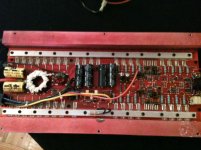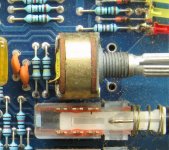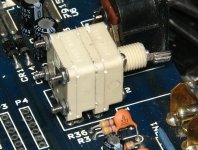Hello,
I have several gen 1 Orion amps that likely need work on the gains. These are the larger 2 channel amps that have a single gain control dial that increases drive when turned CCW.
I wonder if anyone has knowledge about this. Specifically ...
1.) Are suitable replacement gain control units available, if so, what are they?
2.) What is the correct procedure to use when rebuilding the gain controls?
and, related,
3.) When reinstalling the board in the heatsink, is there a preferred/correct product to use for the thermal contact (tape, paste) for these amps?
Thank you in advance for any help!
I have several gen 1 Orion amps that likely need work on the gains. These are the larger 2 channel amps that have a single gain control dial that increases drive when turned CCW.
I wonder if anyone has knowledge about this. Specifically ...
1.) Are suitable replacement gain control units available, if so, what are they?
2.) What is the correct procedure to use when rebuilding the gain controls?
and, related,
3.) When reinstalling the board in the heatsink, is there a preferred/correct product to use for the thermal contact (tape, paste) for these amps?
Thank you in advance for any help!
The first generation had individual potentiometers for left/right.
Are the pots damaged or missing?
If they're only noisy (electrically), contact cleaner may get them usable.
I use Kapton tape and Dow Corning 340. The Kapton MT is the bets of the Kapton materials. The clear/amber 1" tape on a roll is OK. Don't use the thick HN Kapton that's being sold for 3D printers.
Are the pots damaged or missing?
If they're only noisy (electrically), contact cleaner may get them usable.
I use Kapton tape and Dow Corning 340. The Kapton MT is the bets of the Kapton materials. The clear/amber 1" tape on a roll is OK. Don't use the thick HN Kapton that's being sold for 3D printers.
Thanks Perry!
It sounds like inside the single gain control case there are two pots, one left and one right then.
I believe the gain control on one amp is either damaged or incorrect. It is not noisy, but it appears that only one channel is affected when the level is increased. This symptom has been present since the gain control was rebuilt by a tech some time ago. Otherwise everything seems fine. But, I am only speculating at this point, perhaps there is a different issue.
On the other two, the gains seem to basically work, they just squeak when adjusted sometimes, and sometimes will drive the left and right channels at different levels until you nudge them up and down a little. Otherwise these amps seem fine and play nicely.
I believe these are the original gain controls, of the type used in the first gen Orion 250 HCCA, 2150 gx, and others. I haven't done any work yet, and am not even sure how to open the control cases to see what's what. Maybe you know what tool is required, or the procedure for this?
Thank you again.
It sounds like inside the single gain control case there are two pots, one left and one right then.
I believe the gain control on one amp is either damaged or incorrect. It is not noisy, but it appears that only one channel is affected when the level is increased. This symptom has been present since the gain control was rebuilt by a tech some time ago. Otherwise everything seems fine. But, I am only speculating at this point, perhaps there is a different issue.
On the other two, the gains seem to basically work, they just squeak when adjusted sometimes, and sometimes will drive the left and right channels at different levels until you nudge them up and down a little. Otherwise these amps seem fine and play nicely.
I believe these are the original gain controls, of the type used in the first gen Orion 250 HCCA, 2150 gx, and others. I haven't done any work yet, and am not even sure how to open the control cases to see what's what. Maybe you know what tool is required, or the procedure for this?
Thank you again.
No, that looks like what I would expect to see on a "digital reference" (what I would call gen 2) Orion. That switch next to it is probably either "mono" or "eq."
On your second question, with the gain down (fully CW), both channels play at about the same level, and the amp behaves more or less like any other of the same model I have at the same setting. When turning CCW, only one channel significantly responds.
On your second question, with the gain down (fully CW), both channels play at about the same level, and the amp behaves more or less like any other of the same model I have at the same setting. When turning CCW, only one channel significantly responds.
The amp is installed, but I have a pic in which you can see the pot at the lower right.

It is a "moon and stars" - the version that requires the bridging module, etc.
Hopefully that picture will enlarge well on your end and help - I can yank the amp without too much trouble, and will probably need to do that anyhow.

It is a "moon and stars" - the version that requires the bridging module, etc.
Hopefully that picture will enlarge well on your end and help - I can yank the amp without too much trouble, and will probably need to do that anyhow.
Please use the 'Go Advanced' and 'Manage Attachments' option to post images. If someone types out a long reply and then clicks on your image (as posted) all that was typed will be lost.
Try contact cleaner before trying to disassemble that pot. It can be done but there is a real risk of damaging it. To put one back together, I drilled the 4 holes with a #49 drill bit and used #2-64 screws to clamp it back together.
Try contact cleaner before trying to disassemble that pot. It can be done but there is a real risk of damaging it. To put one back together, I drilled the 4 holes with a #49 drill bit and used #2-64 screws to clamp it back together.
Attachments
I'm getting some conflicting advice on how to clean them. I'm afraid I'm going to make them worse or unusable, without having some replacement option.
I would rather leave the amps as original as possible, although they are all 25-30 years old, and several have been worked on already (before I obtained them). I want them to be "right" wherever I can be certain something is "wrong" I guess. There is a short list of things I might want to do on each that involves taking out the boards anyhow, and a gain replacement would be easy to add to that list if the part was available.
After just a little looking, it seems likely there are replacement options available. I'm trying to verify that now without doing any work on the amps themselves. I've been talking to Boland about it, and trying to get a spec sheet on the original pots to try and determine if a reasonable match is available first.
I would rather leave the amps as original as possible, although they are all 25-30 years old, and several have been worked on already (before I obtained them). I want them to be "right" wherever I can be certain something is "wrong" I guess. There is a short list of things I might want to do on each that involves taking out the boards anyhow, and a gain replacement would be easy to add to that list if the part was available.
After just a little looking, it seems likely there are replacement options available. I'm trying to verify that now without doing any work on the amps themselves. I've been talking to Boland about it, and trying to get a spec sheet on the original pots to try and determine if a reasonable match is available first.
Full disclaimer I do not know really what I am doing. I am a trained EE, but not a tech. I have no significant experience doing repairs.
Having said that, I have been told that the use of contact cleaner will result in the pot needing to be replaced, and that what is needed is lubrication rather than cleaning. The recommendation was, wait for it, the almighty WD-40. The source I would prefer not to disclose, other than to say he is highly regarded, as are you.
So I am a little confused. Add to that, one of the amps has already been through two techs. One left the gain in a horrible state, then the second left it in the lopsided-but-non-noisy state it is in now, and claimed he rebuilt it, although per our discussion above it looks quite doubtful that he did any such thing. He says he doesn't think there is anything wrong with the amp.
So, at the very least I wish I knew of a correct replacement. I want to think it over, and see if I get anywhere.
Having said that, I have been told that the use of contact cleaner will result in the pot needing to be replaced, and that what is needed is lubrication rather than cleaning. The recommendation was, wait for it, the almighty WD-40. The source I would prefer not to disclose, other than to say he is highly regarded, as are you.
So I am a little confused. Add to that, one of the amps has already been through two techs. One left the gain in a horrible state, then the second left it in the lopsided-but-non-noisy state it is in now, and claimed he rebuilt it, although per our discussion above it looks quite doubtful that he did any such thing. He says he doesn't think there is anything wrong with the amp.
So, at the very least I wish I knew of a correct replacement. I want to think it over, and see if I get anywhere.
To be honest, I used WD-40, 3 in 1 oil and many other things to clean pots. I quit using WD-40 because it smells like kerosene. I now use and recommend Deoxit D5.
Linear/slide pots will freeze if you clean them. They are different than rotary pots. In 30+ years, I've never seen a rotary pot damaged by cleaning. The exception may be if you use an industrial or brake cleaner that melts the plastic. Get a couple of drops of cleaner in the pot and work it back and forth 50 times (or so) to see if it will clear up.
The amp with one low channel may have a shorted muting transistor. They can fail randomly at any time. IF it's the problem, it could have failed after it left his shop.
If you don't know or understand something, ask. No one knows everything. We can all learn.
Linear/slide pots will freeze if you clean them. They are different than rotary pots. In 30+ years, I've never seen a rotary pot damaged by cleaning. The exception may be if you use an industrial or brake cleaner that melts the plastic. Get a couple of drops of cleaner in the pot and work it back and forth 50 times (or so) to see if it will clear up.
The amp with one low channel may have a shorted muting transistor. They can fail randomly at any time. IF it's the problem, it could have failed after it left his shop.
If you don't know or understand something, ask. No one knows everything. We can all learn.
I am definitely thinking you may be exactly right about the muting circuit failure. When I first directly measured the problem, I thought it could be something like that in the input stage somewhere (?), but wasn't sure what.
I appreciate your help and comments immensely, and highly regard them.
It is definitely possible I will go ahead and try cleaning the pots first. It seems to be a low risk, obvious thing to try, especially with the 2 amps that have an obviously scratchy gain and certainly haven't seen the inside of a shop in years.
I appreciate your help and comments immensely, and highly regard them.
It is definitely possible I will go ahead and try cleaning the pots first. It seems to be a low risk, obvious thing to try, especially with the 2 amps that have an obviously scratchy gain and certainly haven't seen the inside of a shop in years.
The muting transistors are likely marked 2N5639. The amp will work without them so you can pull them to see if it makes a difference.
To avoid damaging the transistors (may not be possible to prevent damaging any of them), remove them as shown below:
http://www.bcae1.com/temp/orionampclamps.swf
To avoid damaging the transistors (may not be possible to prevent damaging any of them), remove them as shown below:
http://www.bcae1.com/temp/orionampclamps.swf
- Status
- This old topic is closed. If you want to reopen this topic, contact a moderator using the "Report Post" button.
- Home
- General Interest
- Car Audio
- Gain control on gen 1 Orion amplifiers

